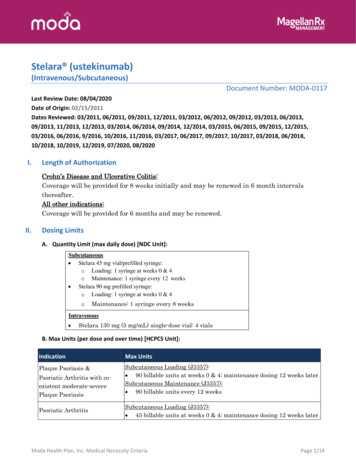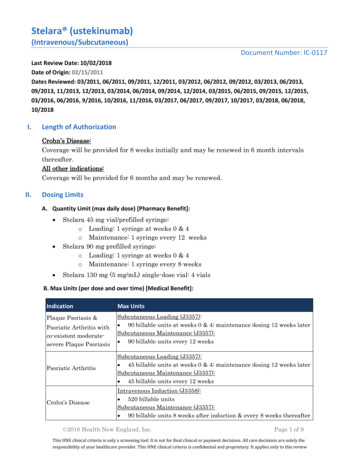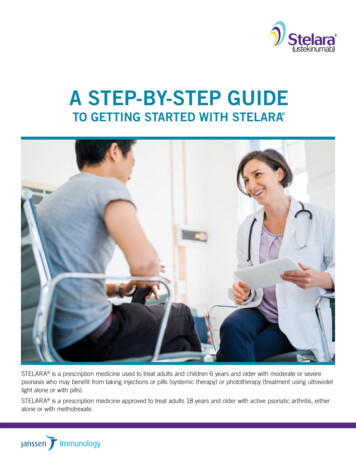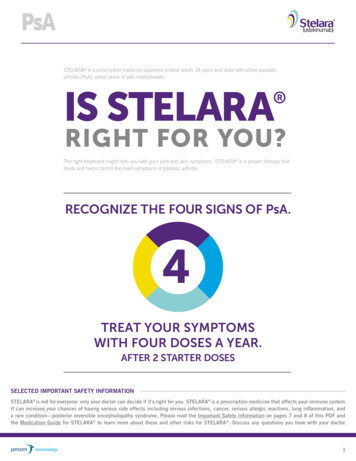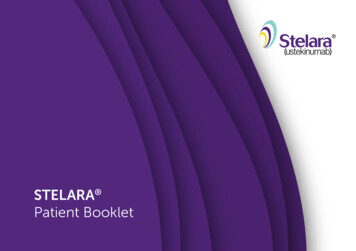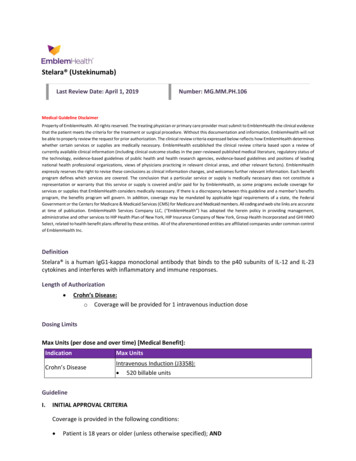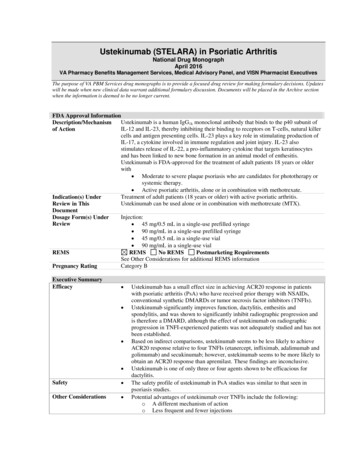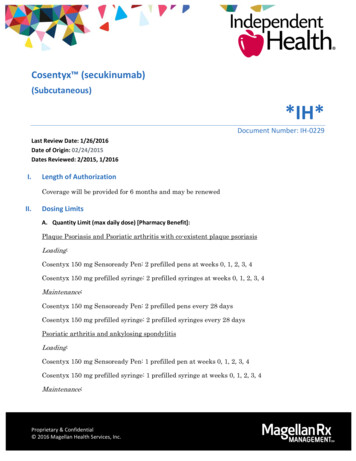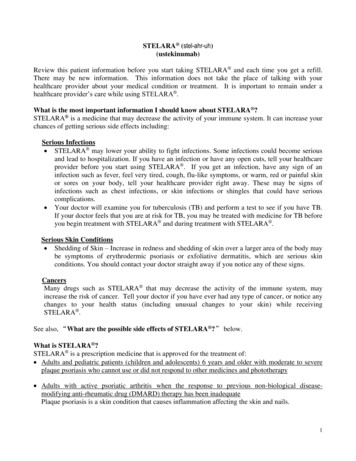
Transcription
STELARA (stel-ahr-uh)(ustekinumab)Review this patient information before you start taking STELARA and each time you get a refill.There may be new information. This information does not take the place of talking with yourhealthcare provider about your medical condition or treatment. It is important to remain under ahealthcare provider’s care while using STELARA .What is the most important information I should know about STELARA ?STELARA is a medicine that may decrease the activity of your immune system. It can increase yourchances of getting serious side effects including:Serious Infections STELARA may lower your ability to fight infections. Some infections could become seriousand lead to hospitalization. If you have an infection or have any open cuts, tell your healthcareprovider before you start using STELARA . If you get an infection, have any sign of aninfection such as fever, feel very tired, cough, flu-like symptoms, or warm, red or painful skinor sores on your body, tell your healthcare provider right away. These may be signs ofinfections such as chest infections, or skin infections or shingles that could have seriouscomplications. Your doctor will examine you for tuberculosis (TB) and perform a test to see if you have TB.If your doctor feels that you are at risk for TB, you may be treated with medicine for TB beforeyou begin treatment with STELARA and during treatment with STELARA .Serious Skin Conditions Shedding of Skin – Increase in redness and shedding of skin over a larger area of the body maybe symptoms of erythrodermic psoriasis or exfoliative dermatitis, which are serious skinconditions. You should contact your doctor straight away if you notice any of these signs.CancersMany drugs such as STELARA that may decrease the activity of the immune system, mayincrease the risk of cancer. Tell your doctor if you have ever had any type of cancer, or notice anychanges to your health status (including unusual changes to your skin) while receivingSTELARA .See also, “What are the possible side effects of STELARA ?” below.What is STELARA ?STELARA is a prescription medicine that is approved for the treatment of: Adults and pediatric patients (children and adolescents) 6 years and older with moderate to severeplaque psoriasis who cannot use or did not respond to other medicines and phototherapy Adults with active psoriatic arthritis when the response to previous non-biological diseasemodifying anti-rheumatic drug (DMARD) therapy has been inadequatePlaque psoriasis is a skin condition that causes inflammation affecting the skin and nails.1
Psoriatic arthritis is an inflammatory disease of the joints, usually accompanied by psoriasis. If youhave active psoriatic arthritis, you will be given STELARA by injection under the skin, alone or incombination with methotrexate, to: Reduce signs and symptoms of your arthritis; Inhibit damage to your joints; Improve your physical function; Improve your enthesitis (pain and swelling around the joints); Improve your psoriasis; Improve your health-related quality of life. Adults with moderately to severely active Crohn’s disease or ulcerative colitisCrohn’s disease and ulcerative colitis are inflammatory diseases of the bowels. If you havemoderately to severely active Crohn’s disease that has not responded to other medications and youare an adult, you will be given STELARA to: Help relieve your symptoms such as abdominal pain and frequent stools, Help get Crohn’s disease or ulcerative colitis under control (induce remission) and keep it undercontrol (maintain remission), Reduce or stop the use of corticosteroid medicines, Improve your health-related quality of life by helping you feel better, Improve the way the lining of your intestine looks to your healthcare provider duringcolonoscopy.STELARA blocks the action of two proteins in your body called interleukin 12 (IL-12) andinterleukin 23 (IL-23). IL-12 and IL-23 are made by your body's immune system. In people withpsoriasis, psoriatic arthritis or Crohn’s disease, IL-12 and IL-23 can cause their immune system toattack normal healthy parts of their body like the skin, nails, joints or the digestive tract. STELARA can block the IL-12 and IL-23 from causing the immune system to attack.Who should not receive STELARA ?You should not receive STELARA if you have: had an allergic reaction to STELARA , or any of the other ingredients in STELARA . See theend of this labeling for a complete list of ingredients in STELARA .an active infection which your doctor considers important.What should I tell my doctor before starting treatment with STELARA ?Your doctor will assess your health before each treatment.Tell your doctor about all of your medical conditions before each treatment, including if you: ever had an allergic reaction to STELARA . Ask your doctor if you are not sure. have any kind of infection even if it is very minor. have an infection that won't go away or a history of infection that keeps coming back. have had TB (tuberculosis), or if you have recently been near anyone who might have TB. have or have had any type of cancer. have any new or changing lesions within psoriasis areas or on normal skin. have recently received or are scheduled to receive a vaccine. Tell your doctor if anyone in yourhouse needs a vaccine. The viruses in some vaccines can spread to people with a weakenedimmune system, and can cause serious problems.2
are receiving or have received ‘allergy shots’, especially for serious allergic reactions.are pregnant, planning to become pregnant, or breastfeeding. STELARA should only be usedduring a pregnancy if needed. Women who are breastfeeding should talk to their doctor aboutwhether or not to use STELARA .have an allergy to latex.have any open cuts or sores as they might get infected.Tell your doctor about all the medicines you take, including prescription and non-prescriptionmedicines, vitamins, and herbal supplements.Know the medicines you take. Keep a list of your medicines and show them to your doctor andpharmacist when you get a new medicine.How will I receive STELARA ? For treatment of psoriasis and psoriatic arthritis, STELARA is given by injection under theskin. For treatment of Crohn’s disease or ulcerative colitis, the first dose of STELARA is given byan intravenous infusion, which means that the medicine will be given to you through a needleplaced in a vein. This dose is given by your healthcare provider. After that, STELARA isgiven by injection under the skin. STELARA is intended for use under the guidance and supervision of your doctor. In childrenand adolescents 6 years and older with psoriasis, it is recommended that STELARA beadministered by a health-care provider. If your doctor determines that it is appropriate, you oryour caregiver may be able to administer STELARA to yourself, after proper training ininjection technique using the right type of syringe and the amount (volume) to be injected (seethe “Instructions for Injecting STELARA under the skin yourself”). Your doctor will determine the right dose of STELARA for you, the amount for each injectionand how often you should receive it. Make sure to discuss with your doctor when you willreceive injections and to come in for all your scheduled follow-up appointments.What should I avoid while receiving STELARA ?You should not receive a live vaccine while taking STELARA .What are the possible side effects of STELARA ?Serious Infections(see “What is the most important information I should know about STELARA ?”).Serious skin conditions(see “What is the most important information I should know about STELARA ?”)Cancer(see “What is the most important information I should know about STELARA ?”).Other serious side effects may occur including allergic reactions.Signs of a serious allergic reaction may include a skin rash, a swollen face, lips, mouth or throat orwheezing, dizziness, trouble swallowing or breathing. Call your doctor or get emergency medicalhelp right away if you think you are having an allergic reaction.3
In rare cases, symptoms such as cough, shortness of breath, and fever may also be a sign of anallergic lung reaction to STELARA .Allergy to latexThe needle cover on the pre-filled syringe contains dry natural rubber (a form of latex). This maycause allergic reactions in people who are sensitive to latex. Tell your doctor if you have ever hadan allergic reaction to latex and developed any allergic reaction to STELARA injection.The most common side effects of STELARA are: Upper respiratory infections such as the common coldInfection of the nose and throatDizzinessHeadacheSore throatDiarrheaNauseaVomitingItchingBack painMuscle achesJoint painFeeling very tiredRedness of the skin where the injection is givenPain where the injection is givenSinus infectionThese are not all of the side effects with STELARA . Tell your doctor about any side effect thatbothers you or does not go away. In general, the side effects of STELARA in children andadolescents 6 years and older are similar to those in adults. Ask your doctor or pharmacist for moreinformation.General information about STELARA Medicines are sometimes prescribed for purposes that are not mentioned in patient information sheets.Do not use STELARA for a condition for which it was not prescribed.How STELARA is storedIf you are using STELARA at home, it is important to store the product at 2ºC to 8ºC (36ºF to 46ºF)in your refrigerator although not in the freezer compartment. STELARA should not be frozen. Do notshake. Keep the product in the original carton to protect from light until the time of use.If needed, individual STELARA pre-filled syringes may also be stored at room temperature up to30 C (86ºF) for a maximum single period of up to 30 days in the original carton with protection fromlight. Record the date when the pre-filled syringe is first removed from the refrigerator and the newexpiry date on the carton in the spaces provided. The new expiry date must not exceed the original4
expiry date printed on the carton. Once a syringe has been stored at room temperature, it should not bereturned to the refrigerator. Discard the syringe if not used within 30 days at room temperature storage.What are the ingredients in STELARA ?The active ingredient is ustekinumab.STELARA 45 mg or 90 mg for injection under the skin: The inactive ingredients include L-histidine,L-histidine monohydrochloride monohydrate, polysorbate 80, sucrose and water for injection. Nopreservatives are present.STELARA 130 mg for intravenous infusion: The inactive ingredients include EDTA disodium saltdihydrate, L-histidine, L-histidine hydrochloride monohydrate, L-methionine, polysorbate 80, sucroseand water for injection. No preservatives are present.Other important points:STELARA is a colorless to light yellow product and may contain a few small translucent or whiteparticles of protein. This appearance is not unusual for solutions containing protein.STELARA 130 mg solution is only for intravenous infusion and must only be given by a healthcareprovider. It is a clear, colorless to light yellow product.STELARA is available in the following presentations:Solution for injection for subcutaneous administration1 Single-use Pre-filled Syringe: 45 mg / 0.5 mL 90 mg / 1.0 mL1 Single-use Vial: 45 mg / 0.5 mLConcentrate for solution for intravenous infusion1 Single-use Vial: 130 mg / 26 mLSTELARA should not be used:- after the expiration date on the label;- if the seal is broken;- if the liquid is discolored, cloudy or you can see other particulate matter floating in it;- if you know, or think that it may have been exposed to extreme temperatures (such as accidentallyfrozen or heated);Always keep medicine out of the sight and reach of children.How to Dispose of STELARA Used syringes should be placed in a puncture-resistant container, like a sharps container. Dispose ofyour sharps container according to your state or local regulations. Empty vials, antiseptic wipes, andother supplies can be placed in your regular trash. The syringe, needle and vial must never be re-used.Discard any unused portion of STELARA in accordance with local requirements.5
Instructions for Injecting STELARA under the skin yourselfYour first STELARA injection may be administered by your healthcare provider. In children andadolescents 6 years and older, it is recommended that all doses of STELARA be administered by ahealth care provider. However, your healthcare provider may decide that it is right for you or yourcaregiver to learn how to inject STELARA under the skin (subcutaneously) yourself. Before youself-inject STELARA , you or your caregiver must be trained by a healthcare professional. Ifyou have not been trained, please contact your healthcare provider to schedule a training session.Call your healthcare provider if you have any questions about giving yourself an injection.INSTRUCTIONS FOR INJECTING STELARA USING A PRE-FILLED SYRINGETo reduce the risk of accidental needle sticks to users, each pre-filled syringe is equipped with a needleguard that is automatically activated to cover the needle after complete delivery of the syringe content.Do not shake STELARA at any time. Prolonged vigorous shaking may damage the product. If theproduct has been shaken vigorously, don’t use it.STEP 1: PREPARING FOR PRE-FILLED SYRINGE USETake the Syringe out of the RefrigeratorCheck the package to make sure that it is the right dose, either 45mg or 90mg as prescribed by yourhealthcare provider. Children who weigh 60 kg or more, may use the pre-filled syringe.Check Expiration DateOpen the box and remove the pre-filled syringe. Check the expiration date on the pre-filled syringe andthe label of the box. If the expiration date has passed, don’t use it.Assemble Additional SuppliesAssemble the additional supplies you will need for your injection. These include an antiseptic wipe, acotton ball or gauze, and a sharps container for syringe disposal.Check Solution in SyringeHold the pre-filled syringe with the covered needle pointing upward. Make sure the syringe is notdamaged. Look at the solution or liquid in the syringe to make sure that it is clear to slightlyopalescent and colorless to slightly yellow. DO NOT use if it is frozen, discolored, cloudy or containslarge particles and contact your healthcare provider for assistance.DO NOT remove the needle cover from the pre-filled syringe.6
DO NOT pull back on the plunger head at any time.STEP 2: CHOOSING AND PREPARING THE INJECTION SITEChoose the Injection Site*Good sites are the top of the thigh and around the tummy (abdomen) but about 2 inches away from thebelly button (navel). Avoid, if possible, skin involved with psoriasis. If your caregiver is giving youthe injection, they may use the upper arms as well.Prepare the Injection SiteThoroughly wash your hands with soap and warm water. Wipe the injection site with an antisepticwipe. DO NOT touch this area again before giving the injection.STEP 3: INJECTING THE MEDICATIONRemove the Needle CoverWhen you are ready to inject, pick up the pre-filled syringe, hold the body of the syringe with one handand pull the needle cover straight off. Throw the needle cover into the trash. You may notice a smallair bubble in the pre-filled syringe. You do not need to remove the air bubble. You may also see adrop of liquid at the end of the needle – this is normal. Do not touch the needle or allow it to touch anysurface.Note: The needle cover should NOT be removed until you are ready to inject the dose. Do not usesyringe if it is dropped without the needle cover in place. If you drop the syringe without the needlecover in place, please contact your healthcare provider for assistance.Inject the MedicationGently pinch the cleaned skin between your thumb and index finger.7
Don’t squeeze it.Push the syringe needle into the pinched skin.Push the plunger with your thumb as far as it will go to inject all of the liquid.Push it slowly and evenly, keeping the skin pinched.When the plunger meets the end of the syringe barrel, and all of the medication has been injected,release the pinched skin and gently remove the needle. Following complete injection, the needle guardwill automatically extend over the needle and lock as you take your hand off the plunger.STEP 4: AFTER THE INJECTIONDispose of the Empty SyringeImmediately dispose of the empty syringe into the sharps container. For your safety and health and forthe safety of others, needles and syringes must NEVER be re-used. Dispose of sharps containeraccording to your local regulations.8
Use a Cotton Ball or GauzeThere may be a small amount of blood or liquid at the injection site, which is normal. You can press acotton ball or gauze over the injection site and hold for 10 seconds. Do not rub the injection site. Youmay cover the injection site with a small adhesive bandage, if necessary.INSTRUCTIONS FOR INJECTING STELARA FROM A VIALDo not shake STELARA at any time. Prolonged vigorous shaking may damage the product. If theproduct has been shaken vigorously, don’t use it. STELARA is not to be mixed with other liquids forinjection.STEP 1: CHECK VIAL(S) AND ASSEMBLE MATERIALSTake the Vial(s) out of the RefrigeratorCheck the package to make sure that it is the right dose, either 45 or 90 mg as prescribed byyour healthcare provider. If your dose is 45 mg you will receive one 45 mg vial. If your dose is90 mg, you will receive two 45 mg vials. If you receive two 45 mg vials for a 90 mg dose, you willneed to give yourself two injections one right after the other.Children weighing less than 60 kg require a dose lower than 45 mg. Make sure you know the properamount (volume) and type of syringe needed for dosing. If you don’t know the amount or type ofsyringe needed, contact your healthcare provider for further instructions.Check Expiration DateOpen the box and remove the vial. Check the expiration date on the vial and the label of the box. If theexpiration date has passed, don’t use it.Check Solution in VialMake sure the vial is not damaged. Look at the solution or liquid in the vial to make sure that it is clearto slightly opalescent and colorless to slightly yellow. DO NOT use if it is frozen, discolored, cloudyor contains large particles and contact your healthcare provider for assistance.Assemble Additional SuppliesAssemble the additional supplies you will need for your injection. These include an antiseptic wipe, acotton ball or gauze, and a sharps container for syringe disposal.9
STEP 2: CHOOSING AND PREPARING THE INJECTION SITEChoose the Injection Site*Good sites are the top of the thigh and around the tummy (abdomen) but about 2 inches away from thebelly button (navel). Avoid, if possible, skin involved with psoriasis. If your caregiver is giving youthe injection, they may use the upper arms as well.Prepare the Injection SiteThoroughly wash your hands with soap and warm water. Wipe the injection site with an antisepticwipe. DO NOT touch this area again before giving the injection.STEP 3: PREPARING THE DOSERemove the cap from the top of the vial but do not remove the stopper.Clean the stopper with an antiseptic wipe.Remove the needle cover from the syringe. Do not touch the needle or allow the needle to touchanything.Put the vial on a flat surface and push the syringe needle through the rubber stopper.Turn the vial and the syringe upside down.10
For adults and pediatric patients (children and adolescents) 6 years of age and older, who weigh 60 kgor more, pull on the syringe plunger to fill the syringe with the amount (volume) of liquid prescribedby your healthcare provider (0.5 mL or 1.0 mL).For children and adolescents 6 years of age or older who weigh less than 60 kg, the amount of liquidprescribed by your healthcare provider may be less than 0.5 mL. Your healthcare provider willrecommend how much liquid is needed.It is important that the needle is always in the liquid in order to prevent air bubbles from forming in thesyringe.Remove the needle from the vial. Hold the syringe with the needle pointing up to see if it has any airbubbles inside. If there are air bubbles tap the side gently until the air bubbles go to the top of thesyringe and press the plunger until all of the air (but none of the liquid) has been removed. Do not laythe syringe down or allow the needle to touch anything.STEP 4: INJECTING THE MEDICATIONGently pinch the cleaned skin between your thumb and index finger. Don’t squeeze it.Push the syringe needle into the pinched skin.Push the plunger with your thumb as far as it will go to inject all of the liquid.Push it slowly and evenly, keeping the skin gently pinched.When the plunger is pushed as far as it will go, take out the needle and let go of the skin.Dispose the Empty Syringe and Vial(s)Discard any unused portion of STELARA in accordance with local requirements. Immediatelydispose of the empty syringe into the sharps container. For your safety and health and for the safety of11
others, vials, needles and syringes must NEVER be re-used. Dispose of sharps container according toyour local regulations. Empty vials can be discarded in regular trash.Use a Cotton Ball or GauzeThere may be a small amount of blood or liquid at the injection site, which is normal. You can press acotton ball or gauze over the injection site and hold for 10 seconds. Do not rub the injection site. Youmay cover the injection site with a small adhesive bandage, if necessary.If your dose amount is 90 mg, and you receive two 45 mg vials, you will need to give a secondinjection right after the first. Use a new needle and syringe. Choose a different site for the secondinjection.STEP 5: WHAT TO DO IF YOU FORGET TO USE STELARA ?If you miss a dose, make the next injection as soon as you remember. Do not double up the injection. Ifyou miss a dose and your psoriasis recurs, call your doctor before taking another injection.Overdose: Call your doctor if you have used more STELARA than instructed.This information sheet summarizes the most important information about STELARA . You can askyour healthcare provider for information about STELARA that is written for healthcare professionals.PRODUCT REGISTRANTJohnson & Johnson Pte Ltd2 Science Park Drive#07-13, AscentSingapore Science Park 1Singapore 118222BATCH RELEASERCilag AGHochstrasse 2018200 SchaffhausenSwitzerlandDATE OF LAST REVISION OF THE TEXT03 May 2021 (CPPI 10 October 2019)12
STELARA is a colorless to light yellow product and may contain a few small translucent or white particles of protein. This appearance is not unusual for solutions containing protein. STELARA 130 mg solution is only for intravenous infusion and must only be given by a healthcare provider. It is a clear, colorless to light yellow product.
